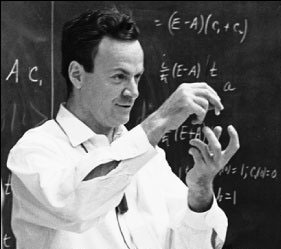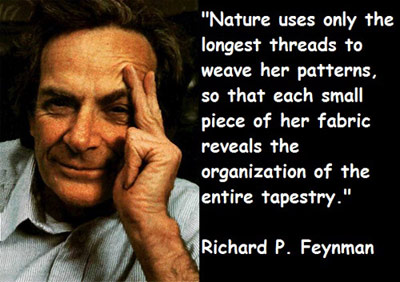Feynman, Richard Phillips (1918–1988)


Richard Feynman was an American theoretical physicist who shared the 1965 Nobel Prize in Physics with Julian Schwinger and Shinichiro Tomonaga (1906–1979) for their independent work on quantum electrodynamics. He also realized, independently of Murray Gell-Mann, that protons, neutrons, and other hadrons must be composed of smaller particles, which he called 'partons'. Later, it was recognized that Feynman's partons and Gell-Mann's quarks (together with gluons) were effectively the same thing, but arrived at by different methods.
Feynman helped to develop the atomic bomb during the Manhattan Project, before going to Cornell University with Hans Bethe where he began his great work on quantum electrodynamics. He was professor of physics at the California Institute of Technology from 1950 until his death. With Gell-Mann, he developed a theory of weak interactions (see weak force), such as those that occur in the emission of electrons from radioactive nuclei. His invention of Feynman diagrams (see below) greatly facilitated theoretical work on elementary particles and their interactions. In 1986 he was a key member of the committee that investigated the Challenger space shuttle disaster.
Feynman diagrams
Feynman diagrams are visual depictions of possible processes in the interaction of elementary particles. They are composed of different types of lines, such as straight, wavy, solid, dotted, or looping, and drawn on charts of two axes, in which the vertical axis represents time and the horizontal one represents space. Subatomic particles are notoriously difficult to observe, and equally hard to visualize. In order to describe accurately these incredibly small, fast, and invisible particles, theoretical physicists, once had to work solely with formulas, relying on their understanding of mathematics to summarize the often very strange behaviors that occur at the quantum level. Then, in 1948, Feynman developed a method to translate the mathematical data into simple, visual depictions. With the aid of the diagrams, theoretical physicists could not only describe and explain what they were doing, but they also found the reverse to be true, that the diagram aided in performing new calculations and opened up unfamiliar areas of research.
Quantum theory assigns to each Feynman diagram the probability amplitude for that process to occur. The total probability is proportional to the square of the sum of the amplitudes of the possible processes, each of which is depicted by a Feynman diagram.
Originally devised by Feynman for his studies in quantum electrodynamics, the diagrams were soon found to be valuable in nuclear, particle, gravitational, and solid-state physics, too. Even learned physicists steeped in mathematics discovered that working with simple diagrams allowed them to better visualize scenarios that had once been purely mathematical. More than that, they had now had a powerful new calculation tool: the Feynman diagram was a new light with which to investigate the darkness.


